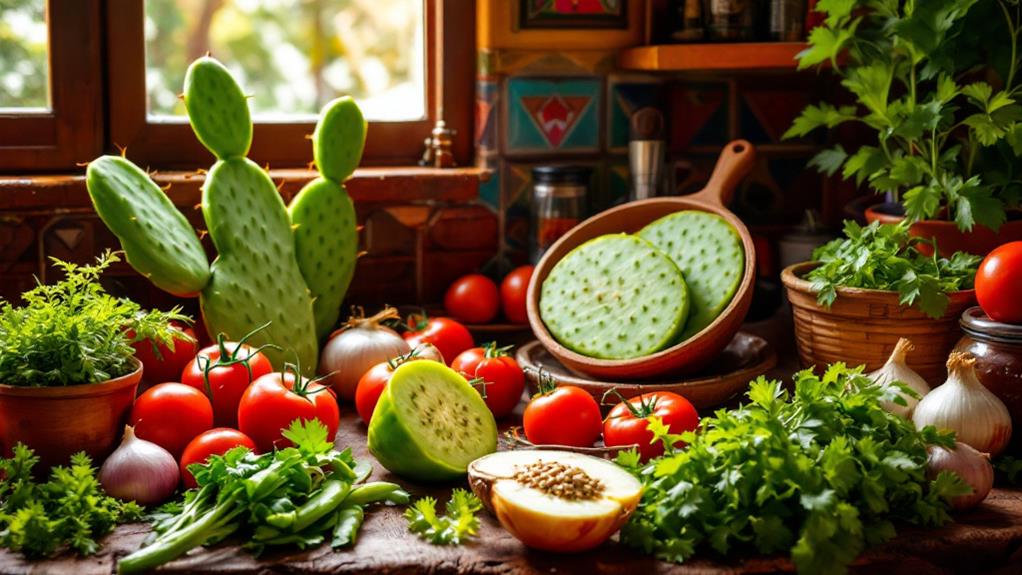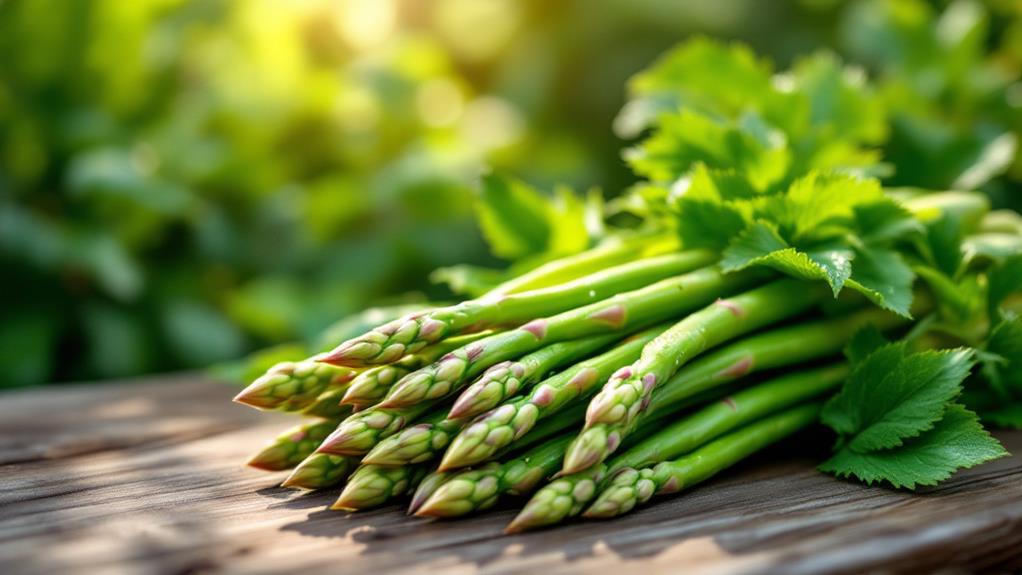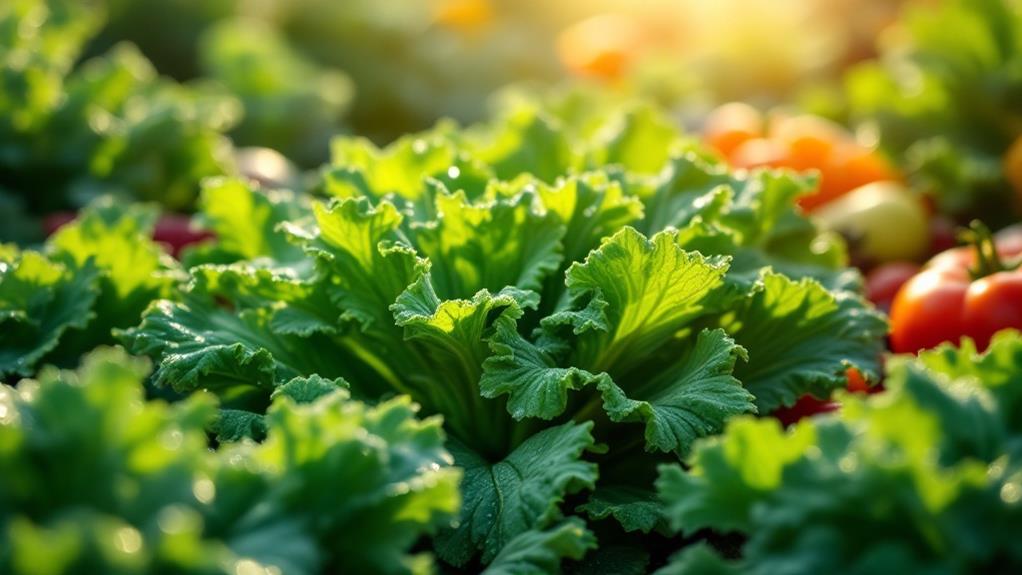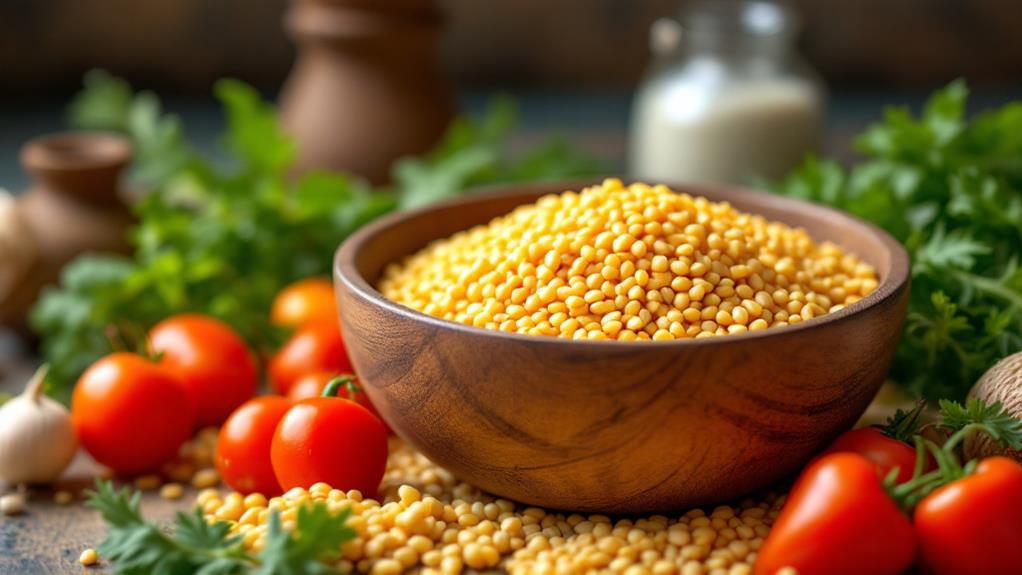The Benefits and Downsides of Consuming Potatoes: A Balanced View
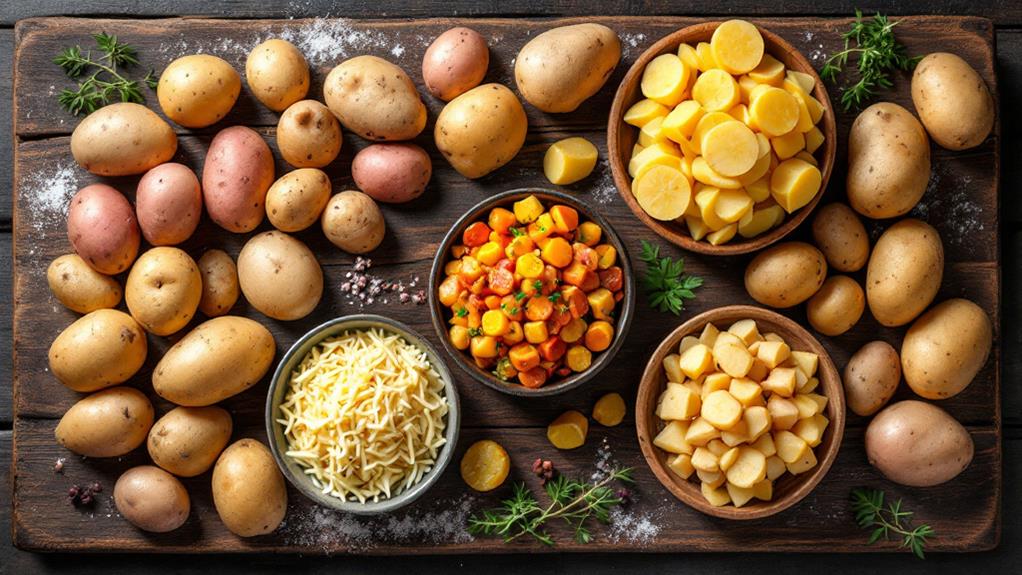
When you eat potatoes, you're tapping into a rich source of vitamin C, potassium, and antioxidants, while enjoying low-calorie, energy-providing carbohydrates. They offer versatility in cooking, like baking starchy Russets or whipping up a salad with waxy reds. However, indulging in fried potatoes can risk weight gain and heart issues, and their high glycemic index needs consideration, especially for diabetics. Remember, preparation matters—boiling or baking retains nutrients, while frying should be limited. Storing them correctly preserves quality and safety. As you investigate, you'll uncover more about balancing these tubers in your diet.
Nutritional Benefits of Potatoes
Potatoes often pack a surprising nutritional punch, making them a valuable improvement to your diet. You might not realize it, but a medium baked potato provides 28% of your daily vitamin C needs, enhancing your immune system and general health. Potatoes are also rich in antioxidants like flavonoids, carotenoids, and phenolic acids, which help combat chronic diseases. These antioxidants are particularly concentrated in the skin, so eating potatoes with the skin considerably optimizes their health benefits.
With only about 161 calories per medium potato, they serve as a low-calorie option while being rich in carbohydrates and fiber. The 36.6 grams of carbohydrates provide crucial energy, and the 3.8 grams of fiber support improved digestion, keeping you feeling full and satisfied longer.
Potassium is another major player in the nutritional profile of potatoes. One medium potato offers 26% of your recommended daily intake, helping lower blood pressure and supporting heart health. This potassium content is crucial for maintaining healthy blood pressure levels, making potatoes an excellent choice for heart-conscious individuals.
Incorporating potatoes into your meals can be a delicious way to support your nutritional needs and general well-being.
Types of Potatoes
When you investigate the world of potatoes, you'll find a wide array of types that cater to different culinary needs. Each type brings its own texture and flavor profile to the table, making them a staple in many dishes.
- Starchy Potatoes: These kinds, like Russet and King Edward, are high in starch and low in moisture. They're perfect for baking and frying, giving you that fluffy interior and crispy exterior.
- Waxy Potatoes: With lower starch content and a creamier texture, waxy types such as red bliss and French fingerlings are your go-to for boiling and making salads. They hold their shape well and add a buttery taste.
- All-Purpose Potatoes: Versatile options like Yukon gold and purple potatoes can handle numerous cooking methods. Yukon gold provides a rich, buttery taste, while purple potatoes offer an enhancement in antioxidant content with their striking appearance.
- Specialty Varieties: Fingerling potatoes are small and finger-shaped, bringing a unique look to your plate. They also come with different nutrient profiles, enriching your diet.
On average, Americans consume about 49.4 pounds of potatoes annually, underscoring their importance in our diet.
Potential Health Risks
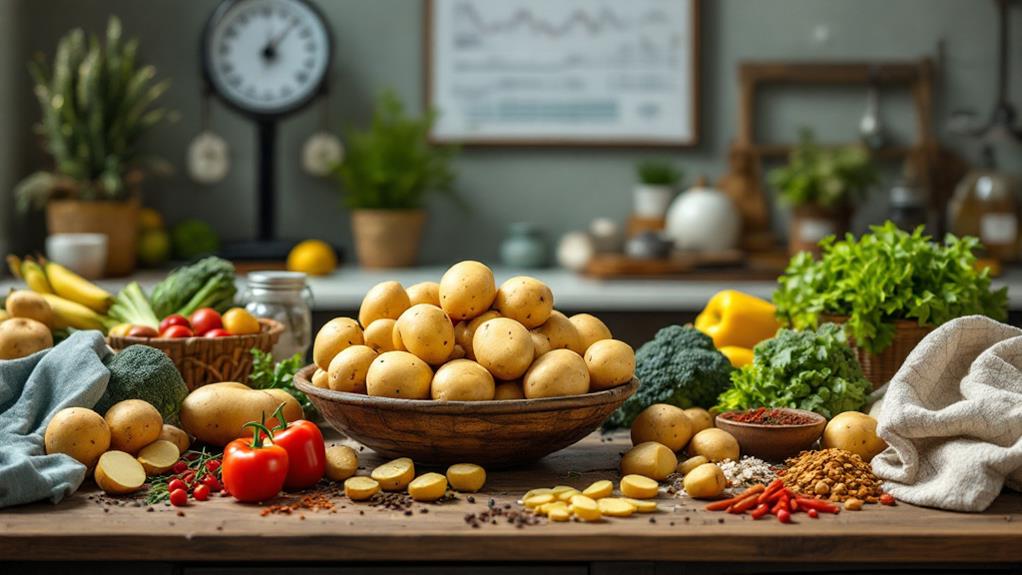
As you savor the diverse flavors and textures that different types of potatoes offer, it's also crucial to be aware of the potential health risks associated with their consumption. Overindulging in fried potato products or those smothered in high-calorie toppings can lead to an increased calorie intake, potentially resulting in obesity and heart disease. Processed potato products are often high in sodium and unhealthy fats, contributing to hypertension and other cardiovascular issues if consumed excessively.
For those managing diabetes or watching carbohydrate intake, moderation is key. Potatoes, especially when not prepared with healthy methods, can have a high glycemic index, impacting blood sugar levels. Always be cautious of green potatoes, as the greening indicates heightened glycoalkaloids, which can be toxic and cause symptoms like vomiting and confusion. It's best to discard any extensively green potatoes to avoid these health risks.
Opting for healthy preparations, such as baking or boiling, can help preserve the nutritional benefits of potatoes while minimizing potential downsides. By being mindful of your choices and portions, you can enjoy potatoes as a delicious part of a balanced diet without the added health concerns.
Cooking and Preparation Tips
Mastering the art of cooking potatoes can greatly improve their health benefits and flavor. Choosing the right cooking methods is essential. Boiling, steaming, and baking are excellent ways to retain nutrients compared to frying, which introduces unhealthy fats and calories. By keeping the skin on potatoes, you optimize their fiber, vitamins, and minerals, as the skin is packed with up to 12 times more antioxidants than the flesh. Here are some practical preparation tips to get you started:
- Choose Your Method: Opt for boiling, steaming, or baking to preserve nutrients. These methods help maintain the natural health benefits of potatoes.
- Keep the Skin On: When possible, leave the skin on potatoes to increase fiber intake and antioxidant content, promoting general well-being.
- Cool for Gut Health: Allow cooked potatoes to cool before consuming. This increases their resistant starch levels, beneficial for gut health and blood sugar control.
- Select Wisely: Purple potatoes offer 3-4 times more antioxidants than white varieties, making them a smart choice for health-conscious meals.
Avoid high-calorie toppings like butter and sour cream. Instead, try healthier alternatives such as Greek yogurt or fresh herbs to improve flavor without compromising your nutritional goals.
Storage and Safety Considerations
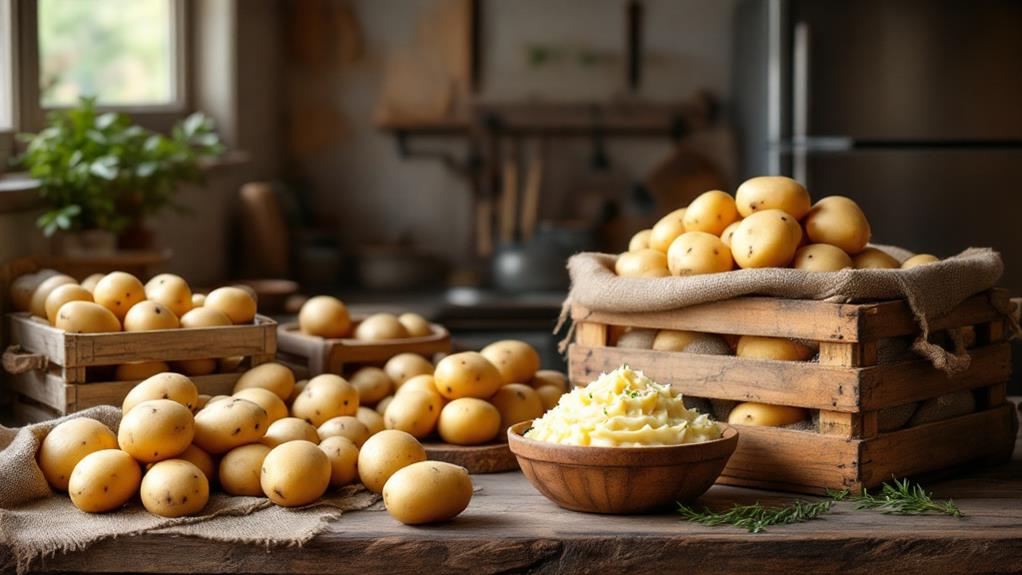
After perfecting your potato cooking techniques, it's vital to understand how to store them properly to maintain their quality and safety. Start by placing your potatoes in a cool, dark area with temperatures between 45-50°F (7-10°C). This helps prevent sprouting and minimizes the formation of glycoalkaloids, which are toxins that increase when potatoes are exposed to light. Avoid refrigeration, as it can cause starches to convert into sugars, resulting in an unpleasant flavor and discoloration when cooked.
Be vigilant for signs of spoilage, such as sprouting, soft spots, and discoloration. Remove any spoiled potatoes promptly to guarantee they don't affect the remaining ones in storage. Proper handling is important; wash your potatoes before storing them to encourage moisture retention, but always discard those that are extensively green or sprouted since cooking won't eliminate their toxins.
Never store potatoes with onions. The gases they emit can cause mutual spoilage, accelerating decay. By following these guidelines, you'll maintain your potatoes' freshness and safety, making sure they're ready for your next culinary creation. Remember, proper storage is key to enjoying potatoes at their best.
Balancing Potato Consumption
With regard to potatoes, balancing their consumption is crucial for reaping their health benefits without unintended drawbacks. Potatoes, when eaten in moderation, can be a valuable enhancement to your diet. They offer a rich nutritional content, including potassium that supports heart health and antioxidants that improve your immune system. To optimize these benefits, consider the following tips:
- Choose Unprocessed Potatoes: Opt for whole potatoes with the skin on. This way, you retain maximum fiber and vital vitamins, which support digestive health.
- Cook Smart: Steer clear of frying. Instead, bake or boil your potatoes to preserve nutrients and cut down on unhealthy fats, keeping calorie content lower.
- Embrace Variety: Don't just stick to one type. Incorporate different varieties, like sweet and purple potatoes, to diversify your nutrient intake and enjoy further health benefits.
- Practice Moderation: While potatoes are nutritious, overindulging can lead to weight gain, especially when loaded with high-calorie toppings. Aim for portion control within a balanced diet.

